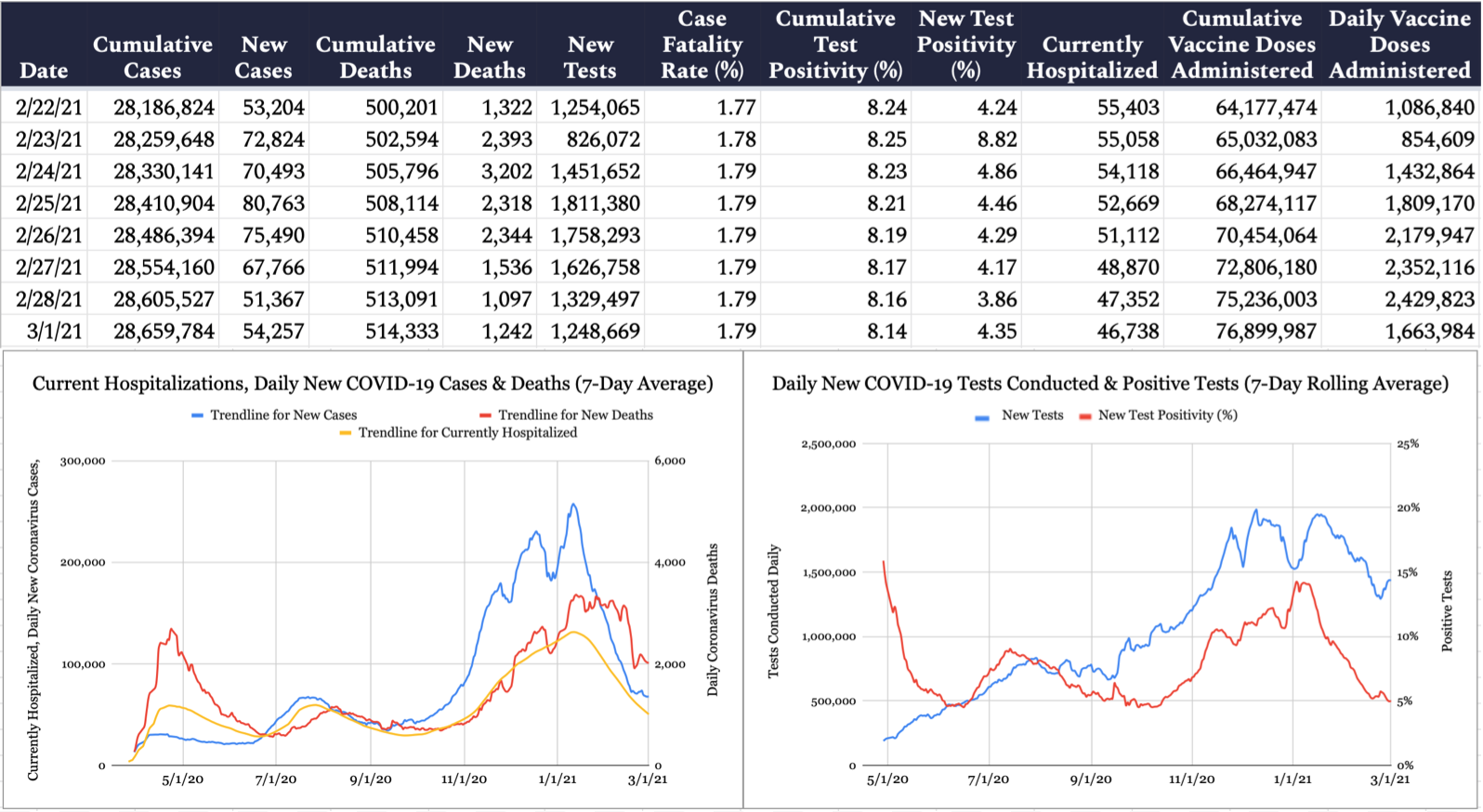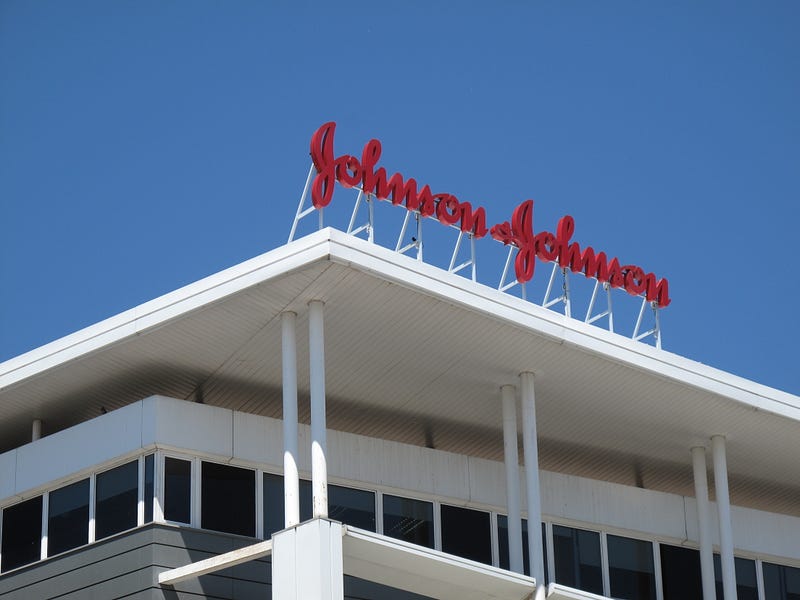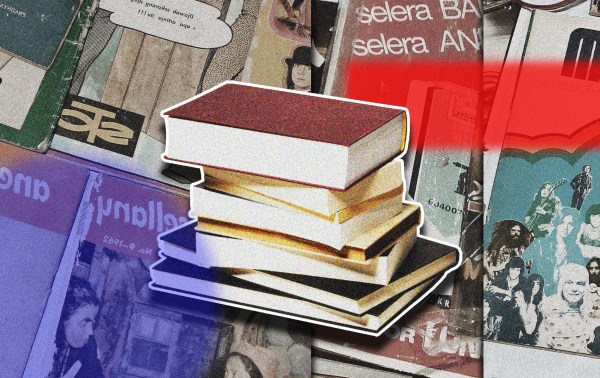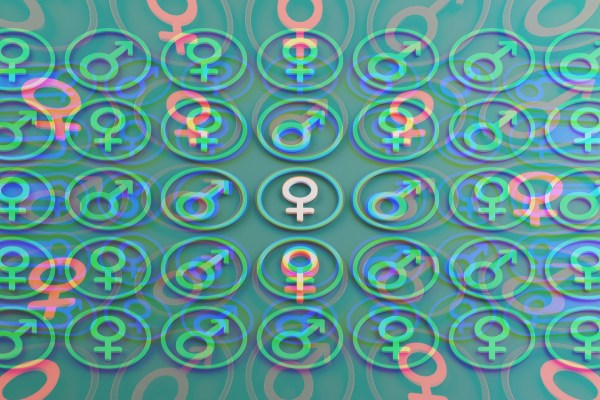Happy Tuesday! The Chicago Cubs are on pace never to lose a game in 2021. It’s just statistics.
Quick Hits: Today’s Top Stories
-
A study found that China permeated regional rival India’s power grid using malware, causing mass blackouts last year after territorial disputes in the Galwan Valley.
-
Former French President Nicolas Sarkozy was hit with a three-year sentence yesterday after a court found him guilty of corruption and influence peddling. Sarkozy plans to appeal the conviction, which stems from his attempt to illegally obtain information from a senior magistrate in exchange for a position in Monaco.
-
The Senate voted 64-33 on Monday to confirm Miguel Cardona as Secretary of Education.
-
A handful of Democratic lawmakers have begun calling on Gov. Andrew Cuomo to resign after a third woman came forward on Monday with an allegation of sexual harassment against the governor.
-
The United States confirmed 54,257 new cases of COVID-19 yesterday per the Johns Hopkins University COVID-19 Dashboard, with 4.4 percent of the 1,248,669 tests reported coming back positive. An additional 1,242 deaths were attributed to the virus on Monday, bringing the pandemic’s American death toll to 514,333. According to the COVID Tracking Project, 46,738 Americans are currently hospitalized with COVID-19. According to the Centers for Disease Control, 1,663,984 COVID-19 vaccine doses were administered yesterday, bringing the nationwide total to 76,899,987.

Vaccine Availability Is About to Boom
The Food & Drug Administration issued an emergency use authorization for Johnson & Johnson’s COVID-19 vaccine over the weekend, meaning a United States itching to return to normal will soon have a third arrow in its quiver in the push to bring the coronavirus pandemic to an end.
The latest entry into the vaccine game brings with it several unique advantages. First and foremost, the Johnson & Johnson vaccine, which doesn’t use the same mRNA technology as its Moderna and Pfizer counterparts, requires only a single shot, rather than two spaced out over several weeks. Not only does this remove the clerical headaches that come with getting people to show up for two appointments, it also means manufactured vaccines go twice as far: 100 million doses of Johnson & Johnson will fully vaccinate 100 million people, not 50 million.
The Johnson & Johnson vaccine also doesn’t need to be kept in sub-zero temperatures like Moderna and Pfizer’s. It will remain potent for up to three months at a comparatively balmy 36 to 46 degrees Fahrenheit. This will have huge logistical implications for vaccine distribution, particularly in rural areas.
“The special handling of Pfizer and Moderna meant that we had to bring people to the vaccines,” Vanderbilt University School of Medicine infectious disease expert Dr. William Schaffner told The Dispatch. “But with Johnson & Johnson, we can bring the vaccine to the people.”
The supply chain has already begun to do just that, with the first truckloads of Johnson & Johnson vaccines arriving at a UPS hub in Louisville, Kentucky yesterday. Due to some manufacturing snafus, Johnson & Johnson will only ship about 4 million doses this week rather than the expected 10 million, but the company maintains they’ll have 20 million doses ready to go by the end of March, and 100 million by June. CEO Alex Gorsky told The Today Show yesterday he hopes to have 1 billion doses distributed by the end of 2021.
With Johnson & Johnson added to the mix, the United States’ vaccine supply is going to boom in the coming months—particularly as Moderna and Pfizer continue to ramp up production. Testifying before the House Energy and Commerce Committee last week, Moderna president Dr. Stephen Hoge said his company is on track to double its monthly allocations, delivering its first 100 million doses by the end of March, second 100 million doses by the end of May, and third 100 million doses by the end of July. Pfizer’s chief business officer John Young was similarly optimistic: 120 million doses by the end of March, another 80 million by the end of May, and 100 million more by the end of July. Young added that Pfizer expects to more than double its weekly shipments from 5 million doses in early February to 13 million by mid-March.
The Johnson & Johnson inoculation’s topline efficacy number (72 percent) has some Americans wondering if they should hold out for a comparatively more effective Moderna or Pfizer vaccine. But that number refers only to the vaccine’s ability to block any symptomatic disease—including a mild fever or case of the sniffles. The efficacy number jumps up to 86 percent with respect to severe disease, and near 100 percent regarding hospitalization and death. Public health experts are encouraging people to get whichever vaccine they are first offered.
“All three of them are really quite good,” Dr. Anthony Fauci told Meet The Press over the weekend. “People should take the one that’s most available to them. If you go to a place and you have J&J and that’s the one that’s available now, I would take it.”
Experts The Dispatch spoke to yesterday affirmed this position, arguing that vaccine efficacy numbers can easily be misinterpreted and clinical trials are not all necessarily conducted the same way. “It’s very difficult to do head-to-head comparisons of the vaccines because they weren’t tested head-to-head,” Schaffner said. “They were tested in divergent populations. The Johnson & Johnson vaccine encountered more of the variants during their testing than did the other two vaccines.”
“The best vaccine is the one that’s available to you today,” he added. “Did Lou Gehrig and Babe Ruth have slightly different batting averages? Yes. So what?”
Dr. Howard Forman, a professor of health policy at Yale University, called the Johnson & Johnson vaccine a “gamechanger.”
“To me, the most important thing remains whether you’re preventing severe disease, hospitalization and death,” he said. “For the most part it seems to be perfectly protective against death and hospitalizations.”
As vaccine manufacturing ramps up, we’ll eventually cross over from having a shortage of supply to having a shortage of demand. “We still have a lot of work to do with hesitancy and people’s acceptance of these vaccines,” Forman said.
But there’s good news on that front as well. Kaiser Family Foundation polling shows vaccine skepticism dropping systematically since December. Fifty-seven percent of respondents in February reported either already receiving a vaccine dose or being willing to get one as soon as they can; that figure is up from just 34 percent two months prior.
In a statement praising the work of Johnson & Johnson, President Joe Biden also warned against loosening COVID-19 protocols and urged all Americans to stay the course.
“There is light at the end of the tunnel, but we cannot let our guard down now or assume that victory is inevitable,” he said. “Though we celebrate today’s news, I urge all Americans—keep washing your hands, stay socially distanced, and keep wearing masks. As I have said many times, things are still likely to get worse again as new variants spread, and the current improvement could reverse.”
Spike in Bond Yields Shows Faith In Economic Recovery
Most U.S. government bond yields fell sharply on Monday, stabilizing the stock market after a volatile week driven in large part by such yields reaching their highest point in a year. The 10-year Treasury yield clocked in at 1.444 percent at Monday’s close, down from 1.525 percent last Thursday. The Dow Jones Industrial Average clawed back 600 points on Monday, allowing investors to recover from last week’s big losses.
The Federal Reserve’s low interest rates have fueled this year’s stock market rally, as bonds have lost their appeal and investors have poured their assets into equities. Last week’s spike in bond yields threatened that trend because rising long-term interest rates tend to make tech stocks less appealing to investors.
But Federal Reserve Chair Jerome Powell has made clear in recent weeks that the central bank has no plans to deviate from its easy-money policies—near-zero interest rates and large-scale bond purchases—until the Fed notches more gains toward its unemployment and inflation goals. “It’s a statement of confidence on the part of markets that we will have a robust and complete recovery,” Powell said last week when pressed on the rise in yields.
Other central banks around the globe reacted much more aggressively to the surge. “The ECB is closely monitoring the evolution of longer-term nominal bond yields,” European Central Bank president Christine Lagarde said. The Reserve Bank of Australia and the Bank of Korea announced additional bond purchases to keep yields low, and the Bank of Japan said they may follow suit.
Many analysts are interpreting the market’s behavior last week as a sign of investors’ faith in economic recovery and rising inflation. “Essentially, the spike in bond yields is saying that everybody thinks that COVID is basically over,” said Luke Lloyd, a wealth adviser and investment strategist at Strategic Wealth Partners.
He added that a spike in bond yields could hurt growth in the long run because the Federal Reserve would respond by raising interest rates. “But as it stays right now,” he said, “if we slowly creep up to about 2 percent on the 10-year [Treasury note], I think that’s probably a healthy thing for the stock market.”
Good news on the vaccine front continues to fuel optimism in economic growth, as does the expectation of forthcoming congressional stimulus. “What the market is clearly seeing and expecting is a whole lot of spending coming,” said Tony Fratto, managing partner at Hamilton Place Strategies and a Treasury Department official in the George W. Bush administration. “The consumer is in a pretty strong place right now.”
“Certainly pockets of the economy are really beat up,” added John Fagan, principal at Markets Policy Partners and former director of the U.S. Treasury’s Markets Room. “But there’s a sense of kind of a coiled spring here, and this is even before Biden’s American Rescue Plan.”
First in The Dispatch: Hogan 2024 Foreshadowing?
An America United—a political advocacy organization supporting Maryland’s Republican Gov. Larry Hogan—is releasing a new advertisement this morning that looks a lot like something you’d see in a presidential campaign.
The four-minute spot—supported by an Avengers-style score—highlights Hogan’s leadership throughout the pandemic and touts his bipartisan approach to politics.
“In this environment, when people usually don’t work together in a bipartisan way, we really did put aside all the politics. We didn’t have red and blue uniforms on,” Hogan says in a voiceover. “We’ve got to decide if we’re going to head in this direction of continuing to practice this kind of crazy, fringe politics on the far right or the far left, or whether we’re going to actually go back to a more traditional Republican party and an America where we can bring people together with a positive, hopeful vision.”
Hogan, reelected easily to a second four-year term in 2018, has not shied away from speculation about a 2024 presidential bid. A longtime critic of former President Donald Trump, he told Bloomberg in December that, while he wasn’t “ready to launch any campaigns,” he wouldn’t rule one out, either. He expanded on his future in the GOP during an interview with TMD’s Declan Garvey in late January.
“I think we’re going to have a four-year battle for the soul of the Republican Party,” Hogan said. “I’m not going to be one of those ones that’s abandoning the party or giving up. … Whether we win this fight or not, time will tell. But it’s worth fighting for, because it’s the party that I believe in—that I’ve spent my whole life fighting for. And I’m not going to let brand new crazy people try to take it over.”
A political advisor to Hogan was coy about Hogan’s aspirations in an interview yesterday, telling The Dispatch that the rationale for the new ad is to “take his message and bring it to the national level.”
“Right now he’s in the middle of a crisis, and he’s focused on governing and he’s focused on vaccine rollout,” the advisor continued. “What this ad is kind of doing is taking that and packaging it in a way that is relevant to a national audience and showing—while CPAC is kind of having this faux convention—he’s governing and he’s doing real things.”
If the video production is a precursor to a future White House bid, Hogan has some work to do over the next few years. He’s incredibly popular in his home state—an October poll pegged his net approval in Maryland at +50 percent, among the highest in the country—but much of that admiration stem’s from Hogan’s crossover appeal with independents and Democrats. Standing out in what is bound to be a crowded Republican primary would be an entirely different challenge.
Hogan, however, believes the message of bipartisan comity he’s selling has broader support than many pundits assume.
“I think there’s a bigger appetite in the public—for either Republicans or Democrats—who really want to focus on problem solving,” he said. “Democrats who are willing to work with Republicans and who are not far left will be rewarded by voters. And Republicans who are not too far right, and who are willing to work together on bipartisan solutions, they’ll be rewarded. And I think that’s where the future is. Whether it can actually happen or not, whether you can ever figure out how to accomplish that with the existing primary structure, with gerrymandering and everything else, I don’t know. But that’s where the voters want people to be.”
Worth Your Time
-
In Matthew Yglesias’ latest Slow Boring newsletter, he lays out just how shortchanged American students have been throughout this pandemic. It’s a complicated issue: While teachers unions bear significant blame for the continued closure of schools, parents haven’t been overwhelmingly in favor of reopening, either—even as study after study finds schools not to be vectors of high transmission. Whatever the reason, our current mishmash of pandemic restrictions doesn’t make much sense, Yglesias argues. “In a world where they’re still giving people snacks on airplanes, letting Ted Cruz jet off for a weekend in Cancún, etc., having schools closed represents an irrational social response to the pandemic,” he writes. “Either the schools should be closed because we’re being super-cautious (in which case indoor dining should be closed), or else the restaurants should be open because we’re not being cautious (in which case schools should be open too).”
-
Unfounded conspiracy theories peddled by right-wing influencers fueled January 6’s violent storming of the Capitol. Now, those influencers are trying to retcon the former president’s role—and that of his supporters—in the incident. In a thoroughly reported piece for the Washington Post, Mike DeBonis and Jeremy Barr chronicle the revisionist history that has taken over the far right and provide ample evidence for why these narratives, however enticing to Trump apologists, contain no substance. “A legion of conservative activists, media personalities and elected officials are seeking to rewrite the story of what happened at the Capitol on Jan. 6, hoping to undermine the clear picture of the attack that has emerged from video and photo evidence, law enforcement officials, journalistic accounts and the testimonials of the rioters themselves,” DeBonis and Barr write. “That a pro-Trump mob, mobilized by the former president’s false claims of a stolen election, stormed the seat of American government to keep Trump in power through violent means.”
Presented Without Comment
Let Us Know
Time for a status update: How’s your quest for a COVID-19 vaccine going? If you’ve gotten yours, what was the process like? If not, when do you expect you’ll be eligible?
Reporting by Declan Garvey (@declanpgarvey), Andrew Egger (@EggerDC), Haley Byrd Wilt (@byrdinator), Audrey Fahlberg (@FahlOutBerg), Charlotte Lawson (@charlotteUVA), Ryan Brown (@RyanP_Brown), and Steve Hayes (@stephenfhayes).







Please note that we at The Dispatch hold ourselves, our work, and our commenters to a higher standard than other places on the internet. We welcome comments that foster genuine debate or discussion—including comments critical of us or our work—but responses that include ad hominem attacks on fellow Dispatch members or are intended to stoke fear and anger may be moderated.
With your membership, you only have the ability to comment on The Morning Dispatch articles. Consider upgrading to join the conversation everywhere.